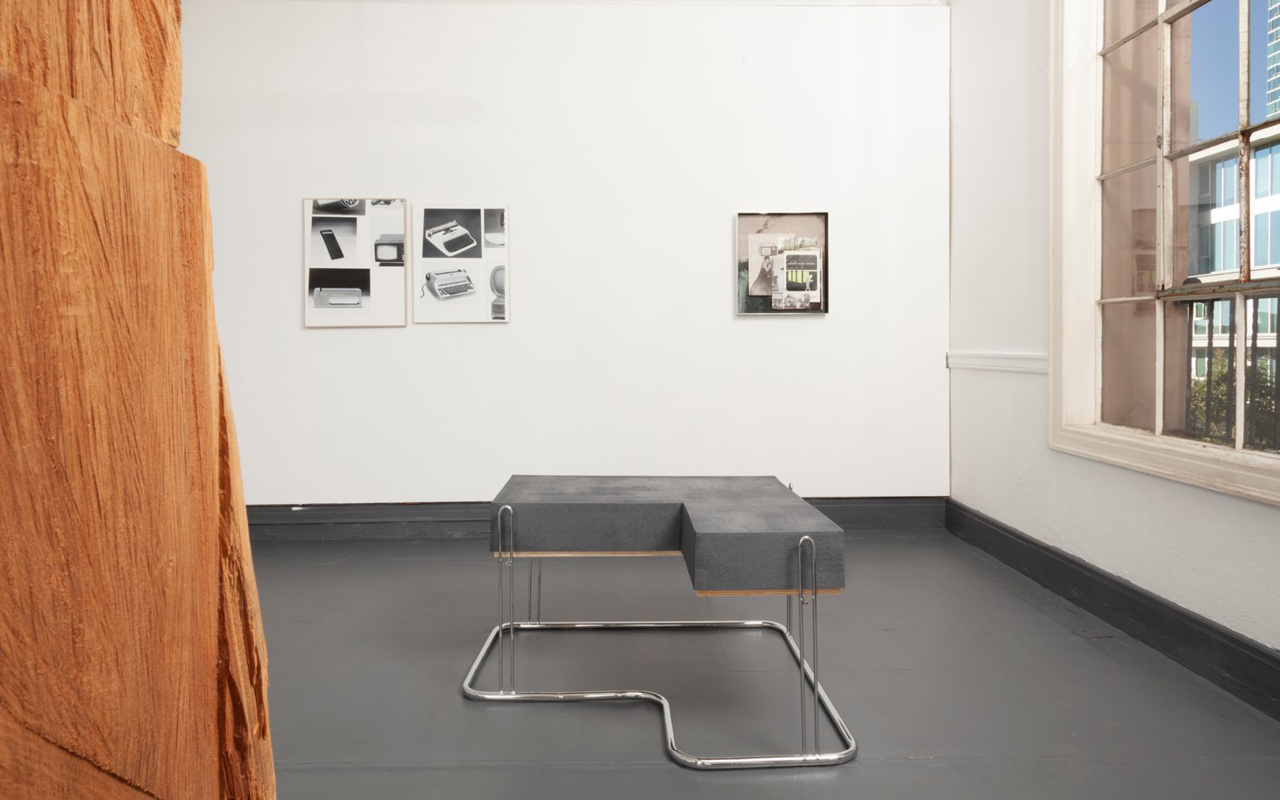Eduardo Consuegra
Endless revisions of what will be
January 25 - February 26, 2020In 2015, Visitor Welcome Center and Eduardo Consuegra agreed to co-lease the space in this building that formerly held daily AA meetings. As the AA relocated down the hall, they divided the 1,400 square foot space into two—one for the gallery and one for the artist’s studio. For Endless revisions of what will be, Consuegra’s studio will transform into an annexed exhibition site of VWC, animating the collaborative relationship between the two.
The artist has created an intimate exhibition of paintings, collages, and sculptures. Considering the Modernist conception of autonomous art and medium specificity, Consuegra appropriates aesthetic tropes born from the movement to question the supposed “universality,” “accessibility,” or “uniformity” of it. Consuegra sees Modernism as a vehicle conceived to prevent cultural specificity and prejudiced misconceptions, and one whose multiple results are revealed through place-specific reinventions. Born and raised in Bogotá, Colombia, Consuegra’s practice stems from both a lived and researched experience of Modernism at large as well as in South America. The continent embraced Modernity’s forward mentality and ideas of progress to redefine itself apart from its northern counterparts and past, grappling with its own perceived identity as it highlighted regional elements and contexts. As Modernity became the prevailing aesthetic social structure in the continent, critics have posited its dissimilar results due to the large and precarious disparity between its ideals and the actual lived experience. The Modernist aspiration to transform life for the better resulted in the uncanny feeling of disassociation and doubt. As Borges described, Modernity in Latin America is not linear; it follows a labyrinthic path, which the artist sees as a sense of wandering loss.
As standardized time created the notion of linear progress, Consuegra reveals technology’s infidelity with time. The artist found an exhibition catalogue from the 1983 Philadelphia Museum of Art show, Design since 1945, and rephotographed the book’s images by distorting them slightly. The technological objects in the catalogue were once the pinnacle of modern design, but many of them have become obsolete and irrelevant. The exercise of rendering these representations that are twice removed—a photograph of the object (the catalogue) and the photograph of the photograph (the artist’s hand)—is an empty meditation in trying to master perfection. The mechanism embodies the moment, but ultimately can’t catch up.
In a continuation of Consuegra’s collage practice, the artist juxtaposes vintage pop culture images from two continents. By making minor cuts on the full pages of the magazine the artist allows for certain parts of the image to be revealed or obscured, provoking a gentle weave that recollects incongruities and politicized approaches to both consumer culture and gender construction. In collaging elements of the two geographies, Consuegra presents a fictional and unsettling experience of distance, diaspora, and desire through the perpetual act of rendering truth through myth.
Eduardo Consuegra lives and works in Los Angeles. Recent exhibitions include: Facsimile, Obra, Malmö Sweden; The White Album, Richard Telles Fine Art; Surface of Color, The Pit; Two Fold, South of Sunset; Perishable Fold, Commonwealth & Council; Black Rabbit, White Hole, Samuel Freeman Gallery; Re-Present, Richard Telles Fine Art: Flicker, Control Room; Specter, Richard Telles Fine Art; Banquet of the Jackal, Luckman Gallery; On Forgery: Is One Thing Better Than Another?, LAXART; and Second Nature: The Valentine/Adelman Collection, Hammer Museum.













